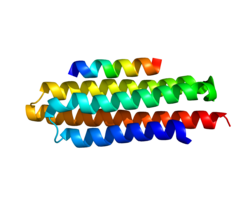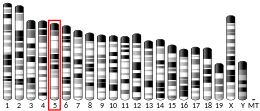پاکسیلین (پروتئین)
پاکسیلین (انگلیسی: Paxillin) یک پروتئین است که در انسان توسط ژن «PXN» کُدگذاری میشود. این پروتئین در چسبندگی سلول به ماتریکس برونیاختهای نقش دارد.
وزن مولکولی پاکسیلین در انسان ۶۴٫۵ کیلو دالتون است و این پروتئین ۵۹۱ اسید آمینه دارد.[۴]
پاکسیلین یک پروتئین وفقدهنده ترارسانی پیام است که در سال ۱۹۹۰ میلادی در آزمایشگاه کیث باریج کشف شد.[۵]
اهمیت بالینی
ویرایشپاکسیلین در برخی از انواع سرطان نقش بالینی مهمی دارد. افزایش بیان پاکسیلین در نواحی پیشسرطانیِ هایپرپلازی، متاپلازی سلول سنگفرشی، و متاپلازی جامیاخته و همچنین نواحی دیسپلاستیک کارسینوما در موارد پُرخطر «آدنوکارسینوم ریه» مشاهده شدهاست.[۶] جهش در ژن «PXN» موجب افزایش رشد تومور، تزاید سلولی و حالت تهاجمی در بافتهای سرطانی ریه میگردد.[۷]
یک یافته ثابت هنگام تغییرات سرطانی، آن است که پروتئین پاکسیلین فسفریله میگردد.[۸] پاکسیلین در «مسیر پیامرسانی MET تیروزین کیناز» نقش بازی میکند که در بسیاری از سرطانها تشدید فعالیت دارد.[۹]
پاکسیلین با وینکولین،[۵][۱۰] تیروزین-پروتئین کیناز CSK[۱۱][۱۲]، توبولین[۱۳]، PTK2[۱۴][۱۵][۱۶] و اینتگرین آلفا ۴[۱۷][۱۸] تعامل پروتئین-پروتئین دارد.
منابع
ویرایش- ↑ ۱٫۰ ۱٫۱ ۱٫۲ GRCm38: Ensembl release 89: ENSMUSG00000029528 - Ensembl, May 2017
- ↑ "Human PubMed Reference:". National Center for Biotechnology Information, U.S. National Library of Medicine.
- ↑ "Mouse PubMed Reference:". National Center for Biotechnology Information, U.S. National Library of Medicine.
- ↑ "Protein sequence of human PXN (Uniprot ID: P49023)". Cardiac Organellar Protein Atlas Knowledgebase (COPaKB). Archived from the original on 13 July 2015. Retrieved 13 July 2015.
- ↑ ۵٫۰ ۵٫۱ Turner CE, Glenney JR, Burridge K (1990). "Paxillin: a new vinculin-binding protein present in focal adhesions". J. Cell Biol. 111 (3): 1059–68. doi:10.1083/jcb.111.3.1059. PMC 2116264. PMID 2118142.
- ↑ Mackinnon AC, Tretiakova M, Henderson L, Mehta RG, Yan BC, Joseph L, Krausz T, Husain AN, Reid ME, Salgia R (Jan 2011). "Paxillin expression and amplification in early lung lesions of high-risk patients, lung adenocarcinoma and metastatic disease". Journal of Clinical Pathology. 64 (1): 16–24. doi:10.1136/jcp.2010.075853. PMC 3002839. PMID 21045234.
- ↑ Jagadeeswaran R, Surawska H, Krishnaswamy S, Janamanchi V, Mackinnon AC, Seiwert TY, Loganathan S, Kanteti R, Reichman T, Nallasura V, Schwartz S, Faoro L, Wang YC, Girard L, Tretiakova MS, Ahmed S, Zumba O, Soulii L, Bindokas VP, Szeto LL, Gordon GJ, Bueno R, Sugarbaker D, Lingen MW, Sattler M, Krausz T, Vigneswaran W, Natarajan V, Minna J, Vokes EE, Ferguson MK, Husain AN, Salgia R (Jan 2008). "Paxillin is a target for somatic mutations in lung cancer: implications for cell growth and invasion". Cancer Research. 68 (1): 132–42. doi:10.1158/0008-5472.CAN-07-1998. PMC 2767335. PMID 18172305.
- ↑ Vande Pol SB, Brown MC, Turner CE (Jan 1998). "Association of Bovine Papillomavirus Type 1 E6 oncoprotein with the focal adhesion protein paxillin through a conserved protein interaction motif". Oncogene. 16 (1): 43–52. doi:10.1038/sj.onc.1201504. PMID 9467941.
- ↑ Lawrence RE, Salgia R (2010). "MET molecular mechanisms and therapies in lung cancer". Cell Adhesion & Migration. 4 (1): 146–52. doi:10.4161/cam.4.1.10973. PMC 2852571. PMID 20139696.
- ↑ Wood CK, Turner CE, Jackson P, Critchley DR (Feb 1994). "Characterisation of the paxillin-binding site and the C-terminal focal adhesion targeting sequence in vinculin". Journal of Cell Science. 107 (2): 709–17. PMID 8207093.
- ↑ Turner CE (Dec 2000). "Paxillin interactions". Journal of Cell Science. 113 (23): 4139–40. PMID 11069756.
- ↑ Turner CE (Dec 2000). "Paxillin and focal adhesion signalling". Nature Cell Biology. 2 (12): E231-6. doi:10.1038/35046659. PMID 11146675.
- ↑ Herreros L, Rodríguez-Fernandez JL, Brown MC, Alonso-Lebrero JL, Cabañas C, Sánchez-Madrid F, Longo N, Turner CE, Sánchez-Mateos P (Aug 2000). "Paxillin localizes to the lymphocyte microtubule organizing center and associates with the microtubule cytoskeleton". The Journal of Biological Chemistry. 275 (34): 26436–40. doi:10.1074/jbc.M003970200. PMID 10840040.
- ↑ Turner CE, Miller JT (Jun 1994). "Primary sequence of paxillin contains putative SH2 and SH3 domain binding motifs and multiple LIM domains: identification of a vinculin and pp125Fak-binding region". Journal of Cell Science. 107 (6): 1583–91. PMID 7525621.
- ↑ Hildebrand JD, Schaller MD, Parsons JT (Jun 1995). "Paxillin, a tyrosine phosphorylated focal adhesion-associated protein binds to the carboxyl terminal domain of focal adhesion kinase". Molecular Biology of the Cell. 6 (6): 637–47. doi:10.1091/mbc.6.6.637. PMC 301225. PMID 7579684.
- ↑ Brown MC, Perrotta JA, Turner CE (Nov 1996). "Identification of LIM3 as the principal determinant of paxillin focal adhesion localization and characterization of a novel motif on paxillin directing vinculin and focal adhesion kinase binding". The Journal of Cell Biology. 135 (4): 1109–23. doi:10.1083/jcb.135.4.1109. PMC 2133378. PMID 8922390.
- ↑ Han J, Liu S, Rose DM, Schlaepfer DD, McDonald H, Ginsberg MH (November 2001). "Phosphorylation of the integrin alpha 4 cytoplasmic domain regulates paxillin binding". J. Biol. Chem. 276 (44): 40903–9. doi:10.1074/jbc.M102665200. PMID 11533025.
- ↑ Liu S, Kiosses WB, Rose DM, Slepak M, Salgia R, Griffin JD, Turner CE, Schwartz MA, Ginsberg MH (June 2002). "A fragment of paxillin binds the alpha 4 integrin cytoplasmic domain (tail) and selectively inhibits alpha 4-mediated cell migration". J. Biol. Chem. 277 (23): 20887–94. doi:10.1074/jbc.M110928200. PMID 11919182.
- مشارکتکنندگان ویکیپدیا. «Paxillin». در دانشنامهٔ ویکیپدیای انگلیسی، بازبینیشده در ۲۴ اوت ۲۰۱۹.
برای مطالعهٔ بیشتر
ویرایش- Panetti TS (Jan 2002). "Tyrosine phosphorylation of paxillin, FAK, and p130CAS: effects on cell spreading and migration". Frontiers in Bioscience. 7 (1–3): d143-50. doi:10.2741/panetti. PMID 11779709.
- Rose DM, Han J, Ginsberg MH (Aug 2002). "Alpha4 integrins and the immune response". Immunological Reviews. 186: 118–24. doi:10.1034/j.1600-065X.2002.18611.x. PMID 12234367.
- Salgia R, Uemura N, Okuda K, Li JL, Pisick E, Sattler M, de Jong R, Druker B, Heisterkamp N, Chen LB (Dec 1995). "CRKL links p210BCR/ABL with paxillin in chronic myelogenous leukemia cells". The Journal of Biological Chemistry. 270 (49): 29145–50. doi:10.1074/jbc.270.49.29145. PMID 7493940.
- Bergman M, Joukov V, Virtanen I, Alitalo K (Feb 1995). "Overexpressed Csk tyrosine kinase is localized in focal adhesions, causes reorganization of alpha v beta 5 integrin, and interferes with HeLa cell spreading". Molecular and Cellular Biology. 15 (2): 711–22. doi:10.1128/mcb.15.2.711. PMC 231937. PMID 7529872.
- Schaller MD, Otey CA, Hildebrand JD, Parsons JT (Sep 1995). "Focal adhesion kinase and paxillin bind to peptides mimicking beta integrin cytoplasmic domains". The Journal of Cell Biology. 130 (5): 1181–7. doi:10.1083/jcb.130.5.1181. PMC 2120552. PMID 7657702.
- Yoshida M, Westlin WF, Wang N, Ingber DE, Rosenzweig A, Resnick N, Gimbrone MA (Apr 1996). "Leukocyte adhesion to vascular endothelium induces E-selectin linkage to the actin cytoskeleton". The Journal of Cell Biology. 133 (2): 445–55. doi:10.1083/jcb.133.2.445. PMC 2120789. PMID 8609175.
- Salgia R, Sattler M, Pisick E, Li JL, Griffin JD (Feb 1996). "p210BCR/ABL induces formation of complexes containing focal adhesion proteins and the protooncogene product p120c-Cbl". Experimental Hematology. 24 (2): 310–3. PMID 8641358.
- Salgia R, Pisick E, Sattler M, Li JL, Uemura N, Wong WK, Burky SA, Hirai H, Chen LB, Griffin JD (Oct 1996). "p130CAS forms a signaling complex with the adapter protein CRKL in hematopoietic cells transformed by the BCR/ABL oncogene". The Journal of Biological Chemistry. 271 (41): 25198–203. doi:10.1074/jbc.271.41.25198. PMID 8810278.
- Retta SF, Barry ST, Critchley DR, Defilippi P, Silengo L, Tarone G (Dec 1996). "Focal adhesion and stress fiber formation is regulated by tyrosine phosphatase activity". Experimental Cell Research. 229 (2): 307–17. doi:10.1006/excr.1996.0376. hdl:2318/37568. PMID 8986614.
- Mazaki Y, Hashimoto S, Sabe H (Mar 1997). "Monocyte cells and cancer cells express novel paxillin isoforms with different binding properties to focal adhesion proteins". The Journal of Biological Chemistry. 272 (11): 7437–44. doi:10.1074/jbc.272.11.7437. PMID 9054445.
- Hiregowdara D, Avraham H, Fu Y, London R, Avraham S (Apr 1997). "Tyrosine phosphorylation of the related adhesion focal tyrosine kinase in megakaryocytes upon stem cell factor and phorbol myristate acetate stimulation and its association with paxillin". The Journal of Biological Chemistry. 272 (16): 10804–10. doi:10.1074/jbc.272.16.10804. PMID 9099734.
- Ostergaard HL, Lou O, Arendt CW, Berg NN (Mar 1998). "Paxillin phosphorylation and association with Lck and Pyk2 in anti-CD3- or anti-CD45-stimulated T cells". The Journal of Biological Chemistry. 273 (10): 5692–6. doi:10.1074/jbc.273.10.5692. PMID 9488700.
- Fernandez R, Suchard SJ (May 1998). "Syk activation is required for spreading and H2O2 release in adherent human neutrophils". Journal of Immunology. 160 (10): 5154–62. PMID 9590268.
- Lewis JM, Schwartz MA (Jun 1998). "Integrins regulate the association and phosphorylation of paxillin by c-Abl". The Journal of Biological Chemistry. 273 (23): 14225–30. doi:10.1074/jbc.273.23.14225. PMID 9603926.
- Ganju RK, Munshi N, Nair BC, Liu ZY, Gill P, Groopman JE (Jul 1998). "Human immunodeficiency virus tat modulates the Flk-1/KDR receptor, mitogen-activated protein kinases, and components of focal adhesion in Kaposi's sarcoma cells". Journal of Virology. 72 (7): 6131–7. PMC 110419. PMID 9621077.
- Deakin NO, Turner CE (Aug 2008). "Paxillin comes of age". Journal of Cell Science. 121 (Pt 15): 2435–44. doi:10.1242/jcs.018044. PMC 2522309. PMID 18650496.
پیوند به بیرون
ویرایش- Paxillin در سرعنوانهای موضوعی پزشکی (MeSH) در کتابخانهٔ ملی پزشکی ایالات متحدهٔ آمریکا


